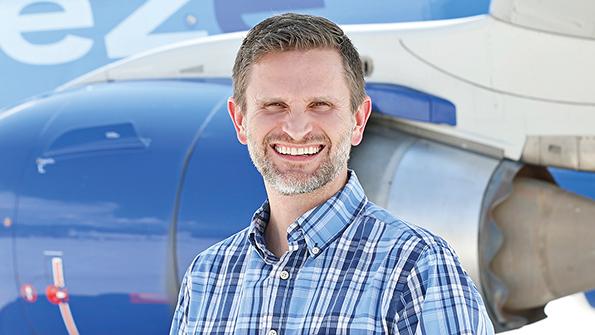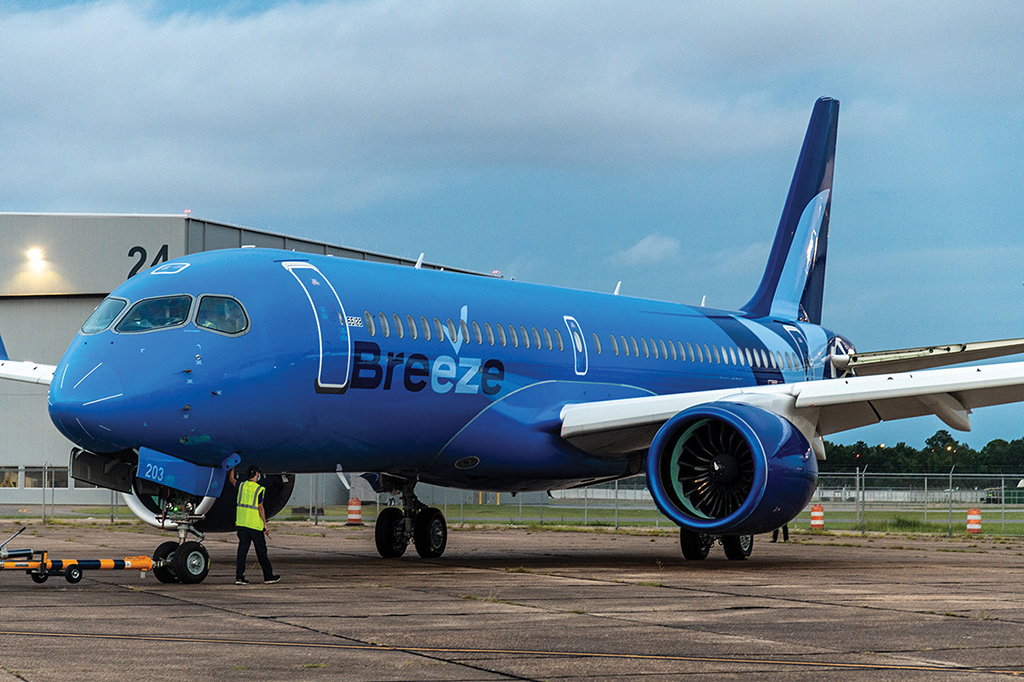
Tom Doxey is president of Breeze Airways.
Tom Doxey, formerly United Airlines’ senior vice president of technical operations and chief financial officer of operations, became president of Breeze Airways in June 2022. He spoke with Lee Ann Shay about fleet expansion and flying charters.
What’s your outlook for the North American low-cost carrier and ultra-low-cost carrier market, especially if JetBlue Airways’ acquisition of Spirit Airlines goes through?
We’ve seen the larger carriers continue to reduce the capacity they have allocated to smaller and midsize airports while they focus on the larger ones. That’s a great thing for us because it opens up opportunity. What they primarily had been flying into those airports were 50- and 70-ish-seat airplanes, in and out of a hub, two to four flights a day. Unless you wanted to go to that hub, you had to connect in that busy airport, which took time. We are flying nonstop to places where people want to go, such as Tampa, Orlando and Jacksonville in Florida; Savannah, Georgia; Charleston, South Carolina; Las Vegas and Los Angeles. It’s an opportunity that has been moving toward us and I think will continue to move toward Breeze.
We’re unique, even compared to some of the other low-cost and ultra-low-cost carriers because they are focused on those large cities; they fly large, dense airplanes and are competing directly with others. For the overwhelming majority of our markets today, we are the only airline that flies nonstop between those two cities. We also provide first-class seats on the Airbus A220—and we have a section within the economy cabin that has more legroom. We’ve got comfortable airplanes providing nonstop service at nice fares.
Are you concerned about inflationary pressures and a potential market slowdown?
I don’t see inflationary pressures having a significant impact on leisure demand, which is what we mostly serve. The inflationary pressures are more about us as a management team making sure that we can properly manage the business—so: what is it going to cost us to buy spare parts, for example? We are focused on managing costs, but I don’t see it impacting demand a lot—at least we’re not seeing any indications of that.
How is the existing fleet operating?
We have 10 A220s and 15 Embraer E-Jets and are getting good performance out of them. We’re using the A220s for a lot of cross-country flying. Typically, the airplane would have an additional segment in its day—so think of it as starting in Hartford [in Connecticut] and going to a place like Pittsburgh or Cincinnati, and then continuing on to a place like San Francisco and then back. That’s the type of routing a typical A220 would do on a given day. That’s a higher utilization for our most efficient airplanes.
We have seen great fuel-burn performance, and our guests and team members really love it, too. That airplane has big windows, big bins, LED lighting and it’s quiet. The pilots really enjoy flying it as well. We have 70 more A220s on firm order, plus another 40 options. We’re basically getting one per month.
We use the E-Jets in two ways. We have 10 E190s and use them primarily for charters, but that’s not how it started out. Initially, we were flying them on scheduled service, but as fuel prices rose and as the charter opportunity presented itself, we shifted that fleet to charter to primarily fly college sports teams. For this season of men’s and women’s basketball, we will be the largest charter operator for that sport, in our first year of operation. We have multi-year agreements with schools such as Brigham Young University, Florida, Nebraska, Notre Dame and Tulane. We also fly a bunch of other schools on a smaller scale. The other five aircraft that are in the fleet, the E195s, we use for shorter-haul scheduled service, such as Charleston to Norfolk, Virginia.
Are you flying the Embraer 190 under Part 135?
No, it’s all under the same [Part 121] certificate.

Credit: Breeze Airways
What is Breeze doing to prepare for receipt of one A220 per month?
We’ve got a great operations team, for one, and we know the importance of having a good operation, so it’s a big part of how we spend our days, ensuring that we have the infrastructure in place. To be able to grow by one airplane per month, we’ve got to make sure we’ve got technicians in place. We have to have pilot training in a good spot. We have a training center here in Salt Lake City, near the airport, where we have a couple of flight simulators.
As we grow, that will continue to grow. A lot of it is about making sure you have the people, the right parts in the right place and the structure that enables growth. David’s [Neeleman] history has been really helpful for us, because he’s been so successful with the other airlines he’s launched. We have a lot of people who want to be a part of our team and what we’re doing—there’s a lot of excitement around it.
For example, we have a pilot who retired as a Boeing 777 captain from Delta who took early retirement during the [early part of the] pandemic. There are many like her who have chosen Breeze to be the airline that they go to for the last three years before they turn 65. On the technician side, we have ex-military folks who are really excited about coming into commercial aviation after retiring from the military, and Breeze is a destination for them. Some of our bases, such as Charleston and Norfolk, have a large military presence, and people don’t want to move. We have opportunities for them to stay in those locations—not something that most other airlines offer.
What maintenance are you doing in-house?
We do line maintenance in-house, and we primarily utilize the OEM partners for the heavier maintenance and for the components and engine type maintenance. We contract with GE for the engines on the E-Jets and Pratt & Whitney for the A220 engines. We just started doing C checks on the E-Jets and have been using Embraer for those.
United Airlines’ and Breeze’s operations are very different, but are there any similarities between the two tech ops?
Tech ops is usually the first place I stop when visiting our bases. At Norfolk, the first thing I do is visit the parts room and talk with the people in our warehouse and to our technicians, and then I go everywhere else. We have very talented people here at Breeze, but that was also the case at United. The difference is just the scope. United had 13,000 in the tech ops organization scattered around the world and focused in the hubs. Breeze has about 1,200 people in the entire airline, and we perform line maintenance only. In both, the people are the best part of it.
